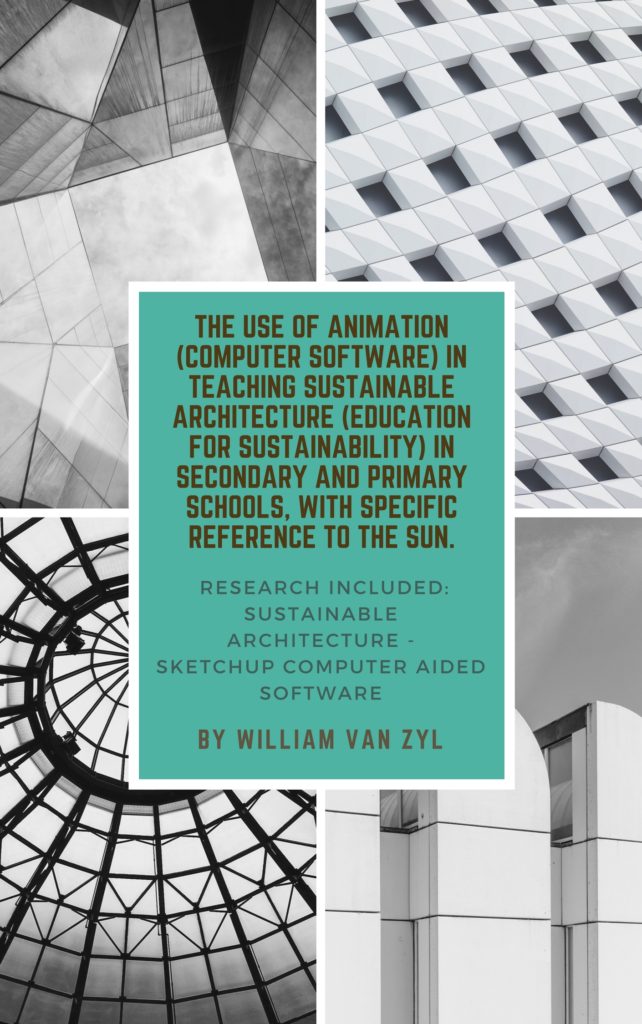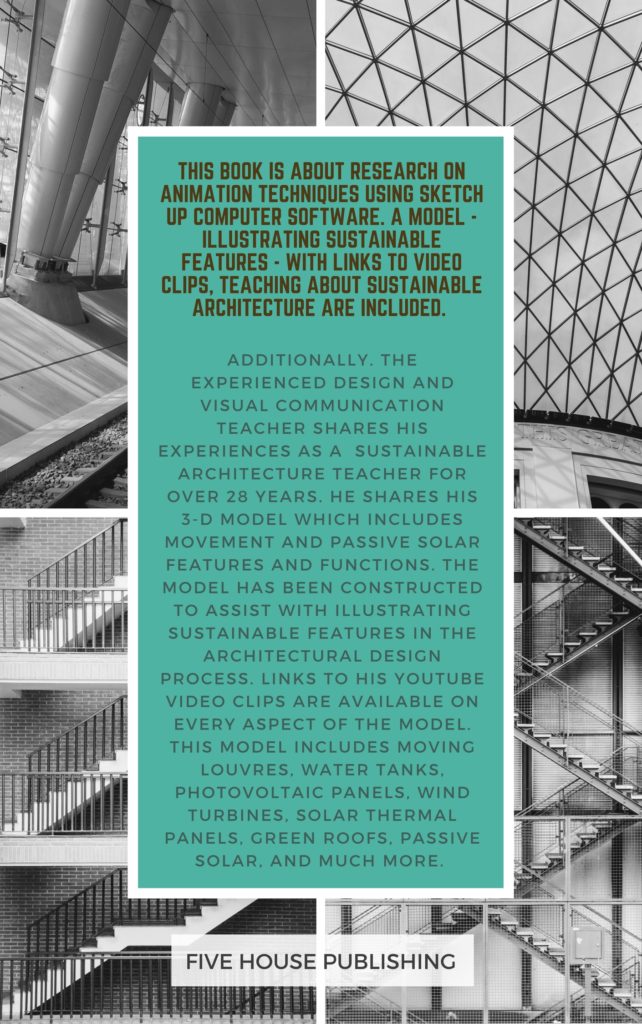Original price was: $4.99.$2.99Current price is: $2.99.
Book details: 19800 words (143 pages) includes images, charts, and some video links. Research – APA style.
Contents
Research Title: 4
The Focus: 4
Synopsis: 4
A short overview of the shadow tools in SketchUp: 6
BACKGROUND OF THE RESEARCHER: 10
WHI WILL BENEFIT FROM THIS RESARCH?. 10
Why should you read this book?. 11
Who should you read this book?. 11
Model illustrating sustainable features and functions: 12
Contents. 14
TITLE: Model Sustainable Architecture: Harvesting sun energy, wind energy and rainwater.
DESCRIPTION:
KEYWORDS:
The Sketch-Up Tools illustrating shadows and shading options: 20
The future, our resources and the United Nations (UNESCO) Millennium Goals: 22
Number 7 of the millennium goals of UNESCO is: 22
THE RESEARCH: 24
Abstract: 24
Keywords/Phrases and Key Concepts. 27
(a) Background: 28
(b) Questionnaires and interviews: a short overview.. 30
(c) Acknowledgements: 30
Chapter 1: Introduction. 32
1.1 Introduction to animation and sustainable architecture. 32
1.2 Animation and simulation in Architectural Design: ‘The ripple effect’ 33
1.3 Google Sketch-up. 34
A typical Daylight Analysis looks like this: 35
1.4 Overview of the five chapters in this study. 40
Chapter 2: Literature Review.. 42
2.1 Introduction. 42
2.2 Environmental Education for Sustainability and critical thinking skills. 42
2.3 Environmental Education for Sustainability: Holistic approach. 45
2.3.1 Holistic curriculum approach. 45
2.3.2 Teaching values and sustainability. 46
2.3.3 Environmental Education for Sustainability (EEFS) and issue based learning. 47
2.3.4 Environmental Education for Sustainability and action for the Environment 48
2.3.5 Environmental Education for Sustainability requires critical education. 49
2.3.6 A futures dimension in EEFS. 50
2.3.7 Hearts, heads, and hands: ‘In’ the environment, ‘about’ the environment, and ‘for’ the environment 51
2.4 Sustainable Architecture. 52
2.5 Education for sustainability (EfS) 53
2.6 Animation and simulation in architectural design: A multi-disciplinary approach. 54
Chapter 3: Methodology. 56
3.1 Introduction. 56
3.2 Research questions. 56
3.3 Research Methodology. 56
3.3.1 Questionnaires. 57
3.3.2 Interviews. 58
3.4 Research design. 59
3.4.1 Sampling strategies. 59
3.4.2 Selection of participants. 60
3.5 Data gathering techniques. 61
Interviews: 62
3.6 Data analysis procedures. 65
3.7 Ethical concerns. 67
3.8 Validity and reliability. 67
3.9 Summary. 69
Chapter 4: Results. 70
4.1 Introduction. 70
4.2 Questionnaires: Analysis of the charts and identifying trends. 71
4.3 Analysis of the Interviews. 72
4.4 Observation and documentation. 79
4.4.1 Critical questions. 80
4.4.2 Critiquing. 81
4.4.3 ‘Stakeholders’ (peers) 82
4.4.4 Science, Mathematics, Accounting and other subject areas. 82
4.4.5 Values. 84
4.4.6 Environmental issues. 85
4.4.7 Action for the environment 85
4.4.8 Critical education. 86
4.4.9 Future dimension. 87
4.4.10 In, about, and for the environment 88
4.4.11 Changing attitudes. 89
4.5 Summary. 90
Chapter 5: Discussion and conclusions. 91
5.1 Overview.. 91
5.2 Conclusions and implications. 95
This study investigated the following two questions: 95
Action research: The practitioner and the respondents. 104
5.3 Implications of this study for secondary school students are: 105
5.4 Recommendations to secondary school teachers: Visual Design and Communication. 107
References. 108
Appendix 1: Questionnaires. 112
QUESTIONNAIRE: BEFORE ANIMATION.. 112
QUESTIONS: After the animation. 120
Appendix 2: Interviews. 128
Interview questions: Before and after animation: 128
INTERVIEW BEFORE ANIMATION.. 128
INTERVIEW AFTER ANIMATION.. 129
Appendix 3: Charts. 132
Appendix 4: Snapshots of interviewee work. 137
Design work of Interviewee 1. 138
Design work of interviewee 4. 140
Figures. 141
ABOUT THE AUTHOR: 142
See Five House Publishing for more books by the author. 143
Description
Research Title:
The Use of Animation (computer software) in Teaching Sustainable Architecture (Education for Sustainability) in Secondary & Primary School, with specific reference to the sun.
The Focus:
The focus of the study is with secondary school students and the use of Sketch-up (computer-aided software) exploring shadows and shading and the choice of sustainable building materials and the selection of sustainable components.
Synopsis:
This book is about teaching Sustainable Architecture to Primary School and Secondary School students.
It contains research information on Animation tools (Sketch Up Computer Aided Design Tools) as well as additional information shared by the author. The author is an experienced Design and Visual Communication teacher with over 28 years of teaching experience. In this book, he shares his research results with Secondary School students. He includes hints, tips and other relevant information, which will benefit teachers and students in the sustainability design processes. Primary school, intermediate and secondary school teachers and students will benefit from this book. For Primary and Intermediate School students and teachers the book goes beyond sustainability concepts like worm farms, composting, and vegetable gardens. The tools discussed here are Sketch Up computer-aided design tools (digital sketching). The software is free to download and very user-friendly (Sketch Up Make). A Professional version is available at an annual registration fee. Students as young as 8 to 10 years of age will be able to master the programme. It is a very user-friendly programme and students will design within minutes after watching the first SketchUp tutorial. Many video tutorials are available on YouTube and at https://www.sketchup.com/learn.
Why should you read this book?
To learn how the animation tools in Sketch Up could improve and open up some new ideas on sustainable architectural design for younger and older children. It will prompt readers to think about different approaches and challenge in-depth investigation of the architectural and sustainable design process. It specifically touches on the sun, passive solar concepts, passive ventilation concepts and the choice of building materials. The book also explains how deciduous trees (shedding leaves during winter) could be used to screen and allow the sun into the buildings. It means that the amount of sunlight (energy) could be regulated by implementing different strategies, and design features.
Who should read this book?
Teachers (primary & secondary), educators, and senior students. Design and Visual Design students. Architecture students. Anyone interested in Sketch-up software for education for sustainability.







